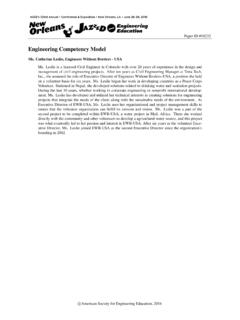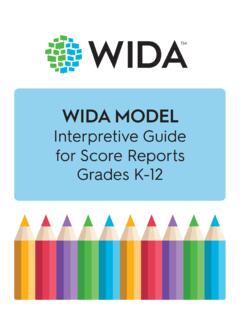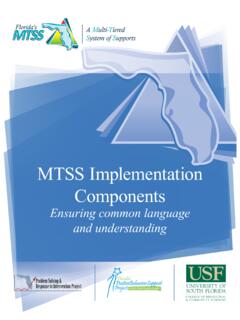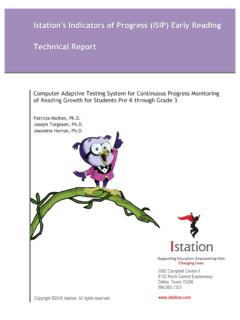Transcription of Response to Intervention and the Pyramid Model - ed
1 Response to Intervention and the Pyramid ModelJune 2009 Lise Fox, Judith Carta, Phil Strain, Glen Dunlap, & Mary Louise HemmeterTechnical Assistance Centeron Social Emotional Interventionfor Young Childrenfor Young Childrenfor Young ChildrenThe reproduction of this document is encouraged. Permission to copy is not publication was produced by the Technical Assistance Center on Social Emotional Intervention for Young Children funded by the Office of Special Education Programs, U. S. Department of Education (H326B070002). The views expressed in this document do not necessarily represent the positions or policies of the Department of Education. No official endorsement by the Department of Education of any product, commodity, service or enterprise mentioned in this publication is intended or should be inferred. Suggested Citation:Fox, L., Carta, J., Strain, P., Dunlap, G., & Hemmeter, (2009). Response to Intervention and the Pyramid Model . Tampa, Florida: University of South Florida, Technical Assistance Center on Social Emotional Intervention for Young Children.
2 To Intervention and the Pyramid ModelLise Fox, Judith Carta, Phil Strain, Glen Dunlap, & Mary Louise Hemmeter Technical Assistance Center on Social Emotional Intervention for Young ChildrenJune, 2009 Response to Intervention (RtI) offers a comprehensive Model for the prevention of delays in learning and behavior. While this problem-solving framework was initially designed for application within Kindergarten to 12th grade programs, there is substantial research that supports the value of the Model for application within early childhood programs. This paper provides an overview of RtI and discusses the Pyramid Model (Fox, Dunlap, Hemmeter, Joseph, & Strain, 2003) and its application for promoting young chil-dren s social compe-tence and preventing behavior challenges. This discussion is offered by the Technical Assis-tance Center on Social Emotional Intervention ( ) to provide guidance to early child-hood professionals and program administrators as they develop policies and procedures related to the adoption of a t i s RtI?
3 Response to Intervention (RtI) is a systematic decision-making process designed to allow for early and effective responses to children s learning and behavioral difficulties, provide children with a level of instructional intensity matched to their level of need and then provide a data-based method for evaluating the effectiveness of instructional approaches. RtI relies on evidence-based instructional practices and frequent progress monitoring to provide the data necessary to make decisions about child progress and the need for more intensive interven-tion. The Model is intended to reduce unnecessary referrals to special education by ensuring that all children in the general education setting have access to high quality curriculum and instruction that are provided in a cascade of intensity, and that each child receives a level of instructional intensity matched to his/her level of need. The Model is not intended to replace special education and its procedural safeguards.
4 RtI was introduced as special education policy in the Individuals with Disabilities Education Improvement Act of 2004 (IDEA 2004). It has its conceptual roots in applied behavior analysis, precision teaching, diagnostic prescriptive teaching, curriculum-based measurement, pre-referral Intervention , data-based deci-sion making and team-based problem solving (Sugai, 2007). Cr i t iC a l Fe a t u r e s o F RtI RtI is based on the premise that supports are provided early, monitored systematically, and adjusted intentionally to respond to individual children s needs, thus preventing the more tradi-tional practice of waiting for a child to demonstrate failure and then beginning a process of evaluation and referral to special education. Instead, RtI includes several features that allow programs to more quickly and efficiently provide the type of support children need to demonstrate successful outcomes. These features include the following: Universal screening:1.
5 In RtI approaches, the performance of all students is evaluated systematically to identify those who are (a) making adequate progress, (b) at some risk of failure if not provided extra assistance, or (c) at high risk of failure if not provided specialized supports. Continuous progress monitoring:2. In RtI approaches, student progress is assessed on a regular and frequent basis in order to identify when inadequate growth trends might indicate a need for increasing the level of instructional support to the of Evidence-Based interventions :3. RtI approaches assume multiple levels, or a cascade, of inter-ventions that vary in intensity or level of support derived Response to Intervention (RtI) is a systematic decision-making process designed to allow for early and effective responses to children s learning and behavioral difficulties, provide children with a level of instructional intensity matched to their level of need and then provide a data-based method for evaluating the effectiveness of instructional scientifically validated research.
6 Typically a core curriculum is provided for all students, modification of this core is arranged for a targeted group of students who do not show adequate growth in Response to the core curric-ulum, and an individualized intensive curriculum is imple-mented for students who do not show adequate growth in Response to the modified curriculum. Data-based decision making and problem solving:4. At the heart of the RtI approach is instructional decision-making based on student performance or growth on curricular outcomes and modifications or adaptations that are implemented when insufficient growth is noted. Implementation Fidelity:5. RtI requires specific proce-dures for regular documentation of the level of implemen-tation ( , were the modifications of the teaching prac-tices implemented consistently and with a high degree of accuracy) of each of the features of the Model . re s e a rC h su p p o r t F o r RtI? While numerous studies have been carried out to validate the specific features of RtI, the evidence base establishing the effec-tiveness of various models or approaches to RtI is still emerging (Hughes & Dexter, 2008; Torgeson, 2009; VanDerHeyden, Witt, & Gilbertson, 2007).
7 Available evidence indicates that use of RtI models can improve the academic performance of at-risk students most notably in the area of early reading skills ( , O Connor, Harty & Fulmer, 2005; Vaughn, Linan-Thompson, & Hickman, 2003). Other studies have shown that students who were involved in programs employing RtI models had reduced rates of special education referral and/or placement ( , Bollman, Silberglitt, & Gibbons, 2007; Marston, Muyskens, Lau, & Canter, 2003; O Conner et al., 2005), or performed better on academic behaviors such as time-on task and task completion (Kovaleski, Gickling, Morrow, & Swank, 1999).ex p a n s i o n o F RtI t o so C i a l/Be h a v i o r Although most studies of RtI have focused on instructional practices in academic areas, some applications of RtI have been reported in the area of instructional support for social behavior, such as School-wide Positive Behavior Support (Sugai et al.)
8 , 2000). RtI models focusing on academic instruction or support for social behavior share an emphasis on prevention and both types of models have created tiered approaches that have their roots in public health ( , Simeonnson, 1994). As Sugai (2001) has described, 3- tier models that are imple-mented in academic systems or behavioral systems are based on the following components:Primary tier prevention1. with all students being exposed to a core curriculum to prevent later problems. Regular screening identifies students who are unsuccessful in Response to instruction with only the core curriculum. Secondary tier prevention2. that is targeted to at-risk students who need some additional instructional support beyond the core tier prevention3. that is generally more inten-sive and individualized and is carried out to remediate academic performance or reduce complications or severity of problem behavior.
9 A critical component underlying the three tiers of instructional support are clear decision rules based on student performance that determine when a student moves up or down the continuum of tiers. Therefore, in either academic or social systems using an RtI approach, the focus is on timely screening, ongoing prog-ress monitoring, and data-based decisions so that more effec-tive interventions can be provided for students whose academic or social behaviors are not responsive to the core curriculum and more intensive interventions (Sugai, 2007). Preventing academic failure and challenging behaviors is the underlying premise of RtI so that all students learning is maximized. ap p l y i n g RtI i n e a r l y e d uC a t i o n: Th e Py r a m i d mo d e l RtI has pragmatic appeal for early education as it is consistent with the conceptual and theoretical framework of early child-hood special education and national recognition of the crit-ical importance of high quality early childhood programs to promote young children s development (Coleman, Buysse, & Neitzel, 2006; VanDerHeyden & Snyder, 2006).
10 Early child-hood special education was developed as a prevention Model with an emphasis on the importance of providing interven-tion and supports to very young children and their families to minimize the impact of disability, risk, or developmental delay on the child s developmental trajectory and learning outcomes (Simeonnson, 1991). Similarly, Head Start, Early Head Start, Title I Preschool, and state-funded preschool programs have been developed in Response to the overwhelming research on the benefit that can be realized when young children attend high quality early education programs or receive Intervention services to address child and family needs (Guralnick, 1997; 2005; Ramey & Ramey, 1998). The common focus across c u r r e n t e a r l y c h i l d h o o d i n i t i a t i v e s i s t h e p r o v i s i o n o f e a r l y e d u c a-tion, Intervention , and family support that will prevent future academic challenges and developmental delays or disabilities (VanDerHeyden & Snyder, 2006).


















